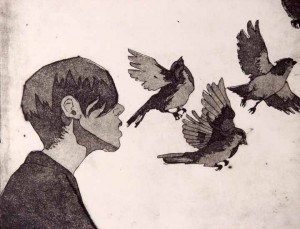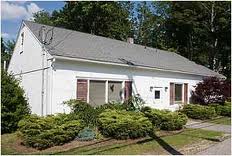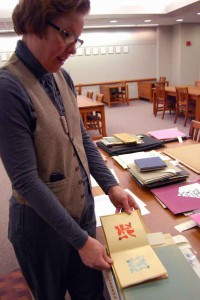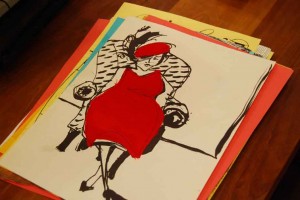Intaglio print by Jenna Simmons ’12, which is representative of the quality of work produced in UConn’s Print Shop. The print was not among the work discovered in the ‘time capsule’ but created there. (Artwork courtesy of J. Simmons)
The building was squat and old. We used a lot of older equipment, which was alright because it felt like they had a history of use. It made me feel closer to the UConn art program to be using things that other students had used in the past. We used old benches and tables. It always smelled strongly of oil and other chemicals. The presses were fun to learn, and the entire processes involved with printmaking were very intricate. I produced some of my favorite work from UConn there.
A remembrance of UConn’s Print Shop by Jenna Simmons ‘12
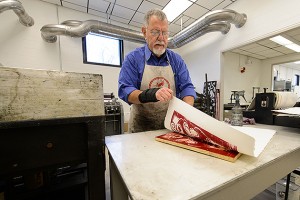
Gus Mazzocca, professor emeritus of art and art history makes a print at the new printmaking facility at the Bishop Center.
Gus Mazzocca, professor emeritus of printmaking, taught at UConn for four decades until his retirement in 2012. As Mazzocca’s rich and distinguished career was drawing to a close and as the UConn print shop – the small, old white house on Route 195 – was scheduled to be replaced by new, more modern quarters in the Bishop Center, Mazzocca contacted Kristin Eshelman, curator of multimedia collections in Archives & Special Collections. His question: was she interested in acquiring several decades of work made by students in his lithography course, specifically 146 artists’ books? Her answer: a resounding ‘yes’!
Mazzocca began teaching lithography in 1971 and continued until his retirement. Revived in the 1960s as a creative medium, lithographs became less expensive to produce with the introduction of aluminum plates instead of lithographic stones. Art school programs could then afford to offer lithography and the resulting use by artists peaked in the 1970s and 1980s. The greatest volume of student work preserved by Mazzocca dates from the 1980s. Not only is the work reflective of popular culture during Mazzocca’s tenure, but Eshelman believes closer inspection will reveal other printmaking techniques and the influence of visiting artists. Professional artists already identified include master book binder Terry Buckley of the U.K who was among those who participated in special curricular programs sponsored by the Art Department.
Student work from the 1980s will be included in an upcoming exhibition entitled, “Out of the Frame: Alternative Arts of the 1980s,” in the Gallery in the Dodd Research Center beginning in March. To learn more, contact Kristin at Kristin.eshelman@uconn.edu.

